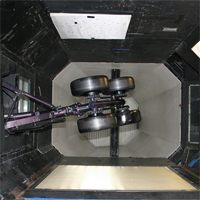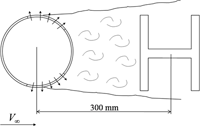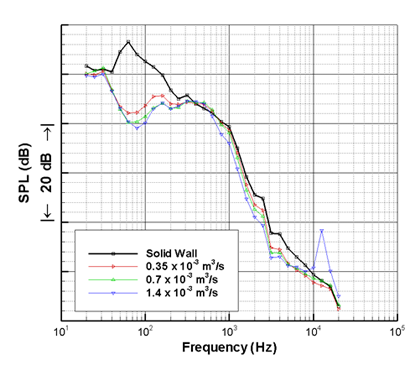The use of blowing to reduce bluff body noise was investigated. Both component self-noise and interaction noise experiments were performed. A small jet applied to the isolated components delayed the roll-up of large flow structures immediately behind the bluff bodies, thereby reducing the unsteady forces on the body. The peak reduction was 38 dB. The reduction using flow control was identically to those with a physical split plate applied to an H-beam up to a frequency of 8 kHz. For the component interaction noise the loudest configuration was the cylinder upstream of the H-beam. Blowing produced a reduction of 16 dB at a frequency of 70Hz. There was a broadband reduction of up to 4 dB up to a frequency of 10 kHz.

Figure 1: 1/4th scale A340 MLG.

Figure 2: Pneumatic split plate.
Landing gear noise is a major contributor to airframe noise. Wakes from upstream components impinging on downstream components are a significant source of noise. This work investigates the use of flow control to reduce the noise generated by bluff bodies. After the bluff body demonstration case the flow control was applied to an A340 main landing gear.
The aim of this work was to assess and develop local blowing flow control methods for bluff body noise reduction. The first demonstration case was on isolated components, i.e. a cylinder and an H-beam. A tandem configuration of an H-beam and a cylinder was used to investigate interaction noise between two bluff bodies. For the isolated components a pneumatic split plate was investigated. A small jet was applied on the rearward face 180 deg. from the stagnation line of two bluff bodies to provide an analogous reduction in bluff body noise to that achieved with a physical split plate. For the interaction case the flow control was applied to the cylinder to break down the large flow structures and to displace the peak turbulence away from the surface of the downstream component.

Figure 3: Interaction noise.
The application of a pneumatic split plate produced reductions for both the cylinder and the H-beam. The effect of applying the flow control to the H-beam was to produce a broadband reduction. The peak reduction was 38 dB at a Strouhal number of 0.13. There was a broadband reduction from 20 Hz to 8 kHz. The blowing coefficient was 9.3 × 10−3. The blowing pressure was supplied at 7 bar. The reduction was identical to the use of a physical split plate of 100mm length.
The loudest interaction configuration was the cylinder upstream of the H-beam. The flow control was applied to the cylinder from 60 deg. to 150 deg. The maximum reduction was 16 dB centred around 70Hz which corresponded to a Strouhal number based on cylinder diameter of 0.18. There was also a further broadband reduction from 800 Hz to 10 kHz of up to 4 dB. From the aerodynamic flowfield investigation it was shown that blowing on the cylinder reduced the large velocity fluctuations in the wake due to breaking down the large flow structures in the wake. This modified the wake that impinged on the H-beam downstream resulting in significantly less noise being generated.

Figure 4: Spectra with pneumatic split plate applied to H-beam.

Figure 5: Spectra for cylinder/H-beam interaction noise with blowing applied to cylinder.
The use of blowing to reduce interaction noise between two bluff body components was investigated. The application of blowing to the cylinder produced a noise reduction for both configurations. A pneumatic split plate was investigated to reduce component self noise. A broadband reduction was achieved for both the H-beam and the cylinder. For the H-beam, the reduction was identical to that achieved with the application of a physical split plate.